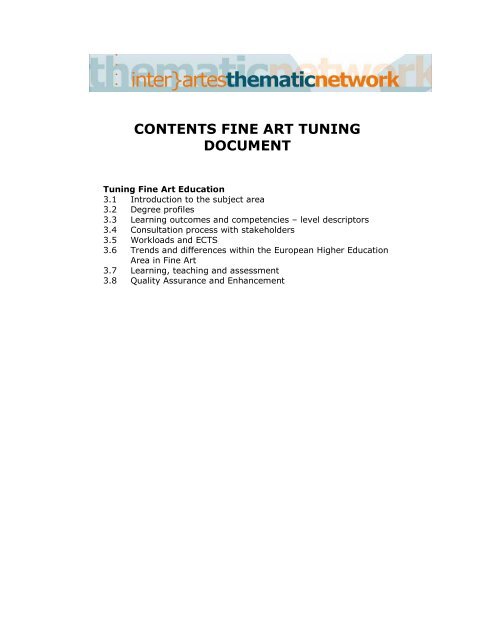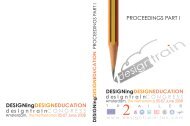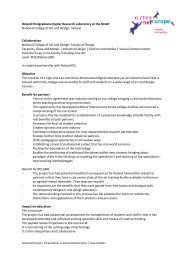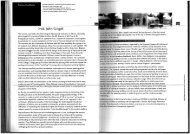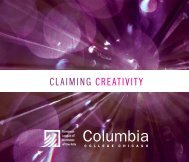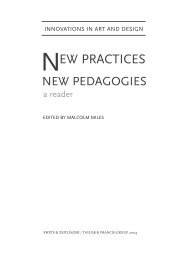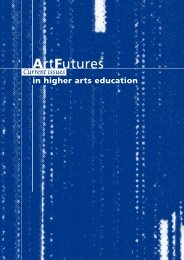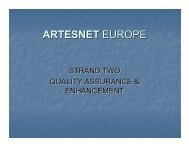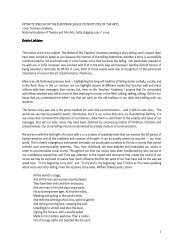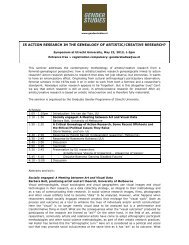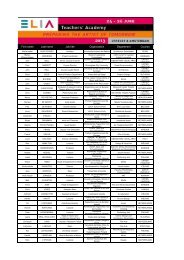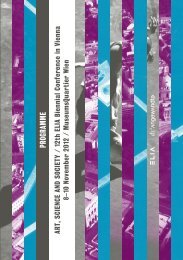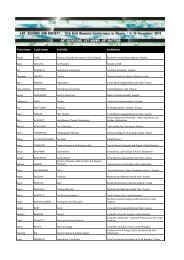CONTENTS FINE ART TUNING DOCUMENT - ELIA
CONTENTS FINE ART TUNING DOCUMENT - ELIA
CONTENTS FINE ART TUNING DOCUMENT - ELIA
Create successful ePaper yourself
Turn your PDF publications into a flip-book with our unique Google optimized e-Paper software.
<strong>CONTENTS</strong> <strong>FINE</strong> <strong>ART</strong> <strong>TUNING</strong><br />
<strong>DOCUMENT</strong><br />
Tuning Fine Art Education<br />
3.1 Introduction to the subject area<br />
3.2 Degree profiles<br />
3.3 Learning outcomes and competencies – level descriptors<br />
3.4 Consultation process with stakeholders<br />
3.5 Workloads and ECTS<br />
3.6 Trends and differences within the European Higher Education<br />
Area in Fine Art<br />
3.7 Learning, teaching and assessment<br />
3.8 Quality Assurance and Enhancement
<strong>TUNING</strong> <strong>DOCUMENT</strong> <strong>FINE</strong> <strong>ART</strong> EDUCATION<br />
This tuning document has been produced by PARADOX, the Fine Art<br />
European Forum, within the framework of the inter}artes thematic<br />
network, strand 2.<br />
3.1 INTRODUCTION TO THE SUBJECT AREA<br />
To describe the characteristics of the subject area Fine Art 1 it is necessary<br />
first to consider Contemporary Art practice and its context in Europe. Art<br />
is a creative and intellectual endeavour that involves artists and other arts<br />
practitioners in a reflexive process where the nature and function of art is<br />
questioned and challenged through the production of new art.<br />
Contemporary Art is a broad and dynamic field encompassing a wide<br />
range of approaches, technologies, contexts, theories, traditions and<br />
social functions 2 . Knowledge and reflection are embodied in artistic<br />
practices and processes. Specific to art is an aesthetic approach to<br />
questioning and exploration, opening up new ways of understanding and<br />
producing meaning and knowledge.<br />
Fine Art higher education involves an integrated approach to production,<br />
theory, critical reflection professional practice 3 technical development and<br />
public manifestation. Diversity is a characteristic of Fine Art higher<br />
education in Europe. It is important that Fine Art programmes continue to<br />
define their own specific qualities, weighting and approaches to their<br />
curricula.<br />
Fine Art education enables students to become creative arts practitioners.<br />
Students learn to develop the necessary imaginative, intellectual,<br />
theoretical and practical skills to equip them for continuing personal<br />
development and professional practice within the arts. Students are<br />
required to actively participate in their own education and to define their<br />
own area of practice, theory and research and the relevant professional<br />
skills that their practice requires. Fine Art education involves modes of<br />
study that lay stress on creativity, improvisation and the questioning of<br />
orthodoxies.<br />
1 For the purposes of this document Fine Art refers to all Higher Education programmes that specialise<br />
in a combination of Art practice with related theory.<br />
2 Artists work in a range of contexts, media and materials and are continuously questioning and<br />
expanding the range of approaches that they employ. They may operate from within a gallery or<br />
museum. Or, work to commission to produce public art, working independently or collaboratively to<br />
make interventions in the virtual or public sphere. These activities come in to being via a wide variety of<br />
specific, multi and interdisciplinary media and forms of presentation, including: painting; sculpture;<br />
installation; drawing; film and video; photography; web based projects; performance and text based<br />
works. Developments in contemporary art practice are reflected in the Fine Art curriculum with courses<br />
offering projects or modules in, for example: socially engaged art practice and site based or site specific<br />
art practice.<br />
3 Professional Practice for arts practitioners includes both practical and conceptual considerations.<br />
Through the development of projects and exhibitions and through lectures and seminars run by artists<br />
and arts professionals, students acquire knowledge and skills to enable them to develop their future<br />
careers including project management; negotiation and teamwork; documentation and presentation and<br />
an approach to writing applications and proposals.
Art is vital for the functioning of the whole of society and Fine Art<br />
programmes play an active role in providing the necessary creative<br />
human capital. Career paths following the study of Fine Art include:<br />
working as an artist; as a teacher of art; as a curator or arts<br />
administrator; as a critic or in some other role in the field of culture. The<br />
transferable skills that students acquire during their studies are also<br />
relevant and valued in a range of other working contexts, in particular<br />
creative and entrepreneurial contexts and management.<br />
In the course of their studies students are given the opportunity to<br />
develop an individual practice and perspective and are provided with the<br />
intellectual and physical space and technical resources where the<br />
transformation from a passive mode to an active form of learning can take<br />
place. This approach to learning enables students to become self<br />
managing reflexive practitioners.<br />
The Fine Art studio is a crucial space in which ideas can take form. The<br />
studio is both a dedicated workspace for individual students and a<br />
discursive space shared by a group of students and tutors who negotiate<br />
its use. The studio is a ‘laboratory’ environment where students can<br />
experiment and test out ideas and approaches, making discoveries and<br />
‘mistakes’. For second and third cycle students may have organised and<br />
established studio space independently based on the specific requirements<br />
of their practice.<br />
For those involved in studying and teaching Fine Art there is a shared<br />
commitment to improving and contributing to the quality and vitality of<br />
cultural experiences. The role of the ‘artist-teacher’ is essential to all Fine<br />
Art programmes 4 . Curators, researchers, theorists and other arts<br />
professionals should also be involved in the delivery of the programme.<br />
Art practice is an activity shared by both students and their tutors, in this<br />
way discussions about the dilemmas and issues raised are both practical<br />
and theoretical and are based on case studies and direct experience.<br />
There are opportunities for students and staff to work alongside each<br />
other on exhibitions and projects and to share the process of installation<br />
and the evaluation of the event.<br />
A feature of Fine Art programmes is the exhibition or project presentation<br />
as a defining assessment point in the first and second cycles. Exhibitions<br />
play a role in offering students targets and deadlines throughout their<br />
studies. Public exhibitions or presentations offer students an opportunity<br />
to bring a body of work to a conclusion, to develop a conceptual and<br />
aesthetic awareness and an understanding of the relationship between<br />
audience and artwork.<br />
The Fine Art programme plays a role within wider communities through<br />
active engagements, residencies, exhibitions, open seminars and<br />
4 In Europe there are different traditions of teaching Fine Art and there may be an academy/atelier<br />
system or a tutorial based system in place. In all cases the necessity for tutors to be practising artists<br />
engaged in and aware of the current discourses in contemporary art is valued.
workshops 5 . Graduates, professional artists and cultural practitioners use<br />
second and third cycle Fine Art programmes to develop and upgrade their<br />
competencies. This experience deepens their understanding and<br />
knowledge of the context and critical discourses related to their work,<br />
developing their practice and career paths.<br />
The wider Fine Art community of education is also a context for study and<br />
exchange. Projects that involve a number of institutions in different<br />
countries play a key role within curricula offering students a broader<br />
perspective on their own practice 6 .<br />
5 The programme team may collaborate with public and private arts institutions and professional groups<br />
to enhance the curriculum and enable students to situate their work in a public context. Fine Art<br />
programmes may also contribute to the local community through schools’ workshops and other forms of<br />
support and involvement. Such activities clearly benefit students by enabling them to develop<br />
professional practice and interpersonal skills. There is also an aspiration that these activities may<br />
encourage those who are currently under-represented, whether for reasons of gender, ethnic origin,<br />
nationality, age, disability, family background, vocational training, geographic location, or earlier<br />
educational disadvantage to participate in Higher Education<br />
6 It is noted in the section on Trends and Differences within the European Higher Education Area in this<br />
Subject, that exchanges are particularly appropriate for the subject due to the self negotiated nature of<br />
Fine Art study and the universality of art as a language.
3.2 DEGREE PROFILES<br />
While some countries have already adopted a three cycle system, others<br />
are at different stages of development with regard to the Bologna process.<br />
Typcial degrees offered in Fine Art<br />
First<br />
cycle<br />
Second<br />
Cycle<br />
Third<br />
Cycle<br />
The typical first cycle Degree in the subject area is entitled Fine<br />
Art. A number of institutions offer programmes, courses or<br />
pathways that emphasise aspects of the subject area for<br />
example: Painting, Sculpture, Printmaking, Fine Art Critical<br />
Practice, Art and Visual Culture, Art in a Social Context and<br />
Curatorial Practice.<br />
Typical elements of the Degree at this level include:<br />
Studio practice, self directed art projects, theory and art<br />
history, research and professional practice.<br />
The typical Degree at second cycle is also called Fine Art. There<br />
are a number of subject specific courses as described for the<br />
First cycle including: Gallery Management and Curation.<br />
Typical elements of the Degree at this level include:<br />
Studio practice, self initiated and self directed art projects and<br />
exhibitions, theory and art history, professional practice<br />
through the development of projects and public exhibitions.<br />
Typical Degrees at third cycle in Fine Art are PhD level<br />
Typical elements of a Fine Art Degree at this level include:<br />
A self initiated and self directed programme of mapped and<br />
evaluated research and practice with a rigorous assessment.<br />
PhD level degrees in Fine Art vary considerably in the weighting<br />
of written to practical work.<br />
Typical occupations of the graduate in Fine Art<br />
The study of Fine Art enables students to develop a range of competencies<br />
including: creative thinking; critical reflection; research skills; project<br />
management; presentation skills; communication and negotiation skills<br />
and technical competence related to their art practice. Such competencies<br />
acquired and enhanced during the course of study results in highly<br />
employable graduates.
First<br />
Cycle<br />
Second<br />
Cycle<br />
Third<br />
Cycle<br />
By the end of this cycle graduates are equipped for<br />
professional practice or further professional development as<br />
artists or arts administrators and will have acquired numerous<br />
transferable skills that prepare them for other employment.<br />
Completion of study may also lead to further study on a<br />
postgraduate Fine Art programme, teaching qualifications or<br />
other subject areas.<br />
By the end of the second cycle graduates will be fully equipped<br />
to function as artists or professionals in fields of culture.<br />
They may also go on to teach Art at various levels or to<br />
practice in creative industries.<br />
By the end of the third cycle graduates are further equipped<br />
for an academic career and have developed their profiles as<br />
professional artists. They will be at the forefront of their<br />
particular field of research, able to contribute and disseminate<br />
results to the wider community.<br />
Role of subject area in other degree programmes<br />
Fine Art may be taken as a component of a combined Honours Degree<br />
programme along with subjects such as Education, Restoration, Art<br />
History and Performance Studies. There are also courses that have a<br />
greater weighting towards theory in which Fine Art practice is in a smaller<br />
or equal proportion to related theoretical study.
3.3 LEARNING OUTCOMES AND COMPETENCIES- LEVEL<br />
DESCRIPTORS<br />
1 st<br />
CYCLE LEARNING OUTCOMES AND COMPETENCIES<br />
Key Subject Specific<br />
Competencies<br />
An ability to:<br />
explore and acquire familiarity with the<br />
language, materials and tools of Fine Art;<br />
develop a knowledge, awareness and<br />
understanding of contemporary and<br />
historical Fine Art practices, theories and<br />
the wider cultural and social context;<br />
develop a professional working basis in<br />
processes, theories, technical skills and<br />
organisation/communication skills<br />
relevant to art practice;<br />
critically reflect on and evaluate their<br />
own work and the work of others;<br />
communicate and articulate ideas<br />
visually, verbally and in writing as<br />
appropriate;<br />
develop an art practice that includes the<br />
production and presentation of a body of<br />
work;<br />
generate creative ideas, experimental<br />
methods, concepts, proposals and<br />
solutions;<br />
negotiate or develop an argument<br />
independently and/or collaboratively in<br />
response to self initiated activity;<br />
demonstrate a conceptual and aesthetic<br />
awareness and an understanding of the<br />
relationship between audience and<br />
artwork;<br />
develop an awareness of the contexts in<br />
which their work may develop;<br />
develop a knowledge of how to operate<br />
within the professional field.<br />
Key Generic<br />
Competencies<br />
An ability to:<br />
develop basic research skills in<br />
order to gather and select,<br />
analyse, synthesise,<br />
summarise and critically judge<br />
information;<br />
develop knowledge and<br />
understanding of theories,<br />
concepts and methods<br />
pertaining to a field (or fields)<br />
of learning;<br />
exercise appropriate<br />
judgement in a number of<br />
complex situations or<br />
contexts;<br />
act effectively within a team<br />
led by experts in the field of<br />
study;<br />
act in variable and unfamiliar<br />
contexts;<br />
manage learning tasks and<br />
workloads independently,<br />
professionally and ethically;<br />
develop presentation skills and<br />
an ability to interact<br />
effectively with audiences;<br />
work and practice effectively<br />
with a knowledge of ethical,<br />
economic and health and<br />
safety implications.
2 nd CYCLE LEARNING OUTCOME AND COMPETENCIES<br />
Key subject Specific<br />
Competencies<br />
An ability to:<br />
further develop and evaluate<br />
working processes appropriate to<br />
individual creative practices;<br />
acquire independent research<br />
skills and utilise them effectively;<br />
display evidence of professional<br />
competencies required for<br />
individual creative practice;<br />
evolve further strategies and<br />
utilise expertise, imagination and<br />
creativity in appropriate media;<br />
develop own criteria for<br />
evaluating and directing work:<br />
question and contextualise<br />
individual practice and that of<br />
others;<br />
articulate an informed position in<br />
the fields of art and culture;<br />
create, sustain, manage,<br />
administer and present an art<br />
practice professionally;<br />
articulate intentions, values and<br />
meanings of works produced to<br />
relevant audiences as well as non<br />
specialised audiences;<br />
consider and evaluate available<br />
relevant pathways to progress.<br />
Key Generic Competencies<br />
An ability to:<br />
develop a systematic understanding<br />
of knowledge informed by the fields<br />
of learning;<br />
cultivate an enhanced critical<br />
awareness of current developments<br />
and/or insights, informed by the<br />
forefront of the fields of learning;<br />
demonstrate a range of standard and<br />
specialised research or equivalent<br />
skills and techniques to a high level;<br />
negotiate and interact effectively with<br />
others to initiate activity;<br />
foresee and adapt to changing<br />
contexts;<br />
self evaluate and take responsibility<br />
for continuing academic/professional<br />
development.
3 rd CYCLE LEARNING OUTCOMES AND COMPETENCIES<br />
Key subject Specific<br />
Competencies<br />
An ability to:<br />
possess a comprehensive knowledge<br />
and understanding of recent advances in<br />
contemporary Fine Art practices,<br />
theoretical discourses and art contexts;<br />
demonstrate skills acquired through<br />
research training and the development<br />
of experimentation/innovative research<br />
and working processes relevant to<br />
artistic projects;<br />
self direct a research project, based on a<br />
focused and well-founded research<br />
proposal;<br />
position the individual research project<br />
in relation to peer review and<br />
published, exhibited and other public<br />
outcomes;<br />
make a public presentation of the<br />
research outcomes, that displays a<br />
significant level of understanding of<br />
audience interaction and reception;<br />
make a contribution at the forefront of<br />
developments in contemporary art and<br />
the wider cultural context.<br />
Key Generic<br />
Competencies<br />
An ability to:<br />
a systematic acquisition and<br />
understanding of a substantial<br />
body of knowledge which is at<br />
the forefront of the field of<br />
learning;<br />
prioritise research activities and<br />
set achievable intermediate<br />
goals appropriate to a project<br />
of advanced research;<br />
employ insight into the<br />
development of working<br />
processes and critical analysis<br />
during the research process;<br />
demonstrate a significant range<br />
of the principal skills,<br />
techniques, tools, practices<br />
and/or materials which are<br />
associated with the field of<br />
learning;<br />
develop new skills, techniques,<br />
tools, practices and/or<br />
materials;<br />
document, report on and<br />
critically reflect on research<br />
findings to specialist and nonspecialist<br />
audiences;<br />
create and interpret new<br />
knowledge, through original<br />
research and advanced<br />
scholarship;<br />
exercise responsibility and a<br />
significant level of perception<br />
and accountability in contexts<br />
that are unforeseen and<br />
ethically complex.
3.4 CONSULTATION PROCESS WITH STAKEHOLDERS<br />
The tuning process initially involved a steering group from PARADOX, the<br />
Fine Art European Forum comprised of: Bob Baker, Head of Fine Art,<br />
School of Art & Design, Limerick Institute of Technology, Ireland; Paula<br />
Crabtree, Dean, Department of Fine Art, Bergen National Academy of Arts,<br />
Norway; Tamiko O’Brien, Course Leader Fine Art: Sculpture, Wimbledon<br />
College of Art, University of the Arts London; Simeon Saiz Ruiz, Dean of<br />
Fine Art, Universidad de Castilla La Mancha, Cuenca, Spain, in March<br />
2006.<br />
A first draft was revised following consultation with colleagues at the<br />
PARADOX working conference in Utrecht on 31 March 31 and 1 April,<br />
2006. The second draft has been disseminated at <strong>ELIA</strong> and inter}artes<br />
events including the <strong>ELIA</strong> Biennial conference in Gent, October 2006 and<br />
inter}artes working conferences in Budapest September 2006; Athens<br />
January 2007; Tallinn April 2007; Stuttgart June 2007; Porto September<br />
2007. Comments have also been invited through the PARADOX and<br />
inter}artes websites.<br />
The steering group consulted a range of documents and papers including:<br />
On the way to a shared set of core values in Fine Art education <strong>ELIA</strong> (Cluj<br />
Romania 2004 ;Four Years, <strong>ELIA</strong>, On the way to a European Higher<br />
Education Area in the Arts, the Dublin Descriptors ; Libro Blanco para<br />
diseno de la Titulacion de grado en Bellas Artes en Espana; HETAC<br />
(Ireland) Standards for Art and Design; Subject Benchmark Statements<br />
UK; National Actions to implement Life Long Learning in Europe, Eurydice<br />
European Unit 2001; Making a European Area of Life Long Learning a<br />
Reality, Commission of European Communities, 2001<br />
3.5 WORKLOAD AND ECTS<br />
First Cycle<br />
Second Cycle<br />
Third Cycle<br />
3 to 4 years 180 to 240 ECTS<br />
1 to 2 years 60 to 120 ECTS<br />
3 to 4 years 180 to 240 ECTS<br />
3.6 TRENDS AND DIFFERENCES WITHIN THE EUROPEAN HIGHER<br />
EDUCATION AREA IN <strong>FINE</strong> <strong>ART</strong><br />
As already outlined in the introduction diversity is both a characteristic<br />
and core value of Fine Art education and programmes may have<br />
distinctive characteristics related to local traditions and the nature of<br />
contemporary Art practice in their locality. Institutions also vary in scale<br />
and economy.
A number of trends have been identified.<br />
• Public interest and demand for art in general has increased, visitor<br />
numbers to major art museums and galleries have risen. It is<br />
recognised that cultural industries contribute significantly to<br />
national and international economies 7 .<br />
• Fine Art practice is dynamic and constantly evolving. Greater<br />
opportunities for artists now exist and there is an increased<br />
awareness of professional practice in Fine Art programmes.<br />
Whereas the acquisition of professional practice skills was usually<br />
implicit and embedded within the Fine Art curricula, there is a<br />
move towards a more explicit recognition of the roles and<br />
relevance of professional practice for Fine Art. Some programmes<br />
feature professional practice as an identified and specific element<br />
of the course. Increasingly this involves collaborations with<br />
partners in cultural institutions.<br />
• There is a trend towards the study of critical theory as integrated<br />
and directly related to students’ own developing art practice. The<br />
relationship between and proportion of theory and practice may be<br />
negotiated with individual students when considering their<br />
programme of work.<br />
• Practice based research degrees are a recent development. There<br />
are a range of approaches to the practice based Fine Art PhD and<br />
the proportion of written work to practice differs across Europe.<br />
The number of artists who have completed the 3 rd<br />
cycle has<br />
increased.<br />
• Developments in learning, teaching and assessment have included<br />
the use of Learning Outcomes and assessment used as a positive<br />
learning tool that involves students in peer review. There is a<br />
general move towards a more accountable and transparent<br />
approach to teaching that is student-centred and focused on<br />
learning.<br />
• Developments in technology have impacted on the way students<br />
learn. The internet has greatly expanded the opportunities for<br />
research in current international practices. In some institutions a<br />
Virtual Learning Environment provides the opportunity for students<br />
and staff to access programme documentation and information.<br />
The VLE also provides a context for students to access each<br />
other’s work and can be used as a tool for students involved in<br />
organising and negotiating group work.<br />
• Exchanges have become a feature of the curriculum. They are<br />
appropriate for Fine Art students because of the emphasis on<br />
negotiated self directed study. The nature of international<br />
contemporary art facilitates participation in programmes in other<br />
countries.<br />
• Artists are constantly renewing and refreshing their knowledge of<br />
the field of Fine Art. As a result Fine Art students can be from a<br />
7 (UK department for culture, media and sport reports 1998, 2001, Arts Council of Ireland ‘Arts Plan’<br />
2002-2006). Fine Art education has increased in popularity accordingly leading to a wide range of career<br />
opportunities (Dutch research project on careers 2004).
wide age range. Fine Art is a key subject area in which life long<br />
learning and widening participation are viable.<br />
A number of differences have been identified:<br />
• Some institutions consider that traditional subject disciplines<br />
provide students with useful contexts from which they can focus<br />
their studies. Others have established broad based courses where<br />
students can engage in multi disciplinary forms of practice.<br />
• Models of teaching are diverse in Europe. There is a tradition of<br />
the academy/atelier system where students work with one tutor or<br />
professor for a number of years and develop a dialogue with that<br />
artist and their practice. In other countries students may work<br />
with a number of different tutors and visiting artists during their<br />
period of study.<br />
• Admissions procedures vary across the sector. In some countries<br />
students are required to have completed a diagnostic ‘Foundation’<br />
or ‘Access’ course of varying lengths. Others recruit students<br />
directly from second level education 8 .<br />
• Currently there is a diversity of programme lengths. Many<br />
countries are moving towards a 3 cycle structure.<br />
• Part time study is offered in a number of countries in a range of<br />
formats and over a different numbers of years. Part time students<br />
may swap between part time and full time modes or vice versa as<br />
their circumstances change 9 .<br />
• Fine Art education in Europe is provided by a range of institutions<br />
including: universities, specialist academies and colleges of higher<br />
or further education. While the standard of the programmes and<br />
students’ achievements are comparable there may be differences<br />
between the resources available and the level to which academic<br />
staff are supported to undertake their own research.<br />
• Different structures are employed by institutions in delivering the<br />
curriculum. Some programmes are modularised or unitised where<br />
students can choose components that involve study in subjects<br />
other than Fine Art. Many programmes are specifically holistic in<br />
approach, where the different components of the curriculum are<br />
imbedded rather than explicit.<br />
3.7 LEARNING, TEACHING AND ASSESSMENT<br />
Fine Art curricula and teaching and learning practices have developed in<br />
response to changes in the nature of contemporary art practice and the<br />
wider cultural and social context. Innovations and curriculum development<br />
have been required in order for students to be prepared for and engage in<br />
contemporary art practice.<br />
8 Admissions may be based on: exam results; drawing/aptitude tests; a week long project based<br />
competence test; portfolio interviews or group critique and group interview. Students may be selected<br />
by an individual professor that works with them for the duration of the programme. In other institutions<br />
teams of staff select students for the programme.<br />
9 This has increased participation by learners previously under represented in Higher Education.
Students are involved in a wide range of learning activities 10 . Assessment<br />
is employed as a learning tool and students are expected to play an active<br />
role in the assessment of work. This may be through assessment by group<br />
critique, by writing critical evaluation reports on their own progress and<br />
/or peer evaluation.<br />
Example 1:<br />
Work or project placements/ residencies<br />
These projects may initially involve students in seeking out and<br />
negotiating their placement and considering the practical, social, ethical<br />
and health and safety implications. The placement is discussed with tutors<br />
and approaches to the relevant individuals and institutions are made.<br />
Students gain first hand experience of the issues and good practices<br />
associated with their placement. Students document their experiences and<br />
are assessed on a presentation of their evaluation of the project made to<br />
their peers and tutors. In this way the student group gains valuable<br />
information and insight from their peers’ experiences as well as<br />
developing their own presentation skills.<br />
Example 2:<br />
Peer Evaluation and student participation in assessment<br />
This form of assessment involves students in analysis, evaluation and<br />
debate with their peers. It is devised to make assessment criteria and<br />
processes more transparent and in this way enables students to take<br />
more responsibility for their own learning. Students work in teams to<br />
discuss the criteria and their own and others performance in relation to<br />
learning outcomes. They may write a progress report and compare results<br />
with that of other teams and tutors’ evaluation.<br />
Peer Evaluation provides students with a substantial and rigorous learning<br />
experience that enables them to consider future directions and effectively<br />
evaluate areas for development. This process encourages students to gain<br />
insight into their own and other’s work and ideas.<br />
Example 3:<br />
A student presentation<br />
Making presentations enables students to acquire confidence in<br />
communicating to a group and provides them with the opportunity to test<br />
out and develop presentation skills. The peer learning involved in<br />
observing and discussing each others’ presentations is valuable and<br />
enables students to develop their critical awareness and capacity for<br />
reflection.<br />
Students are required to give a visual and verbal presentation on their<br />
own work considering it in relation to other historical or contemporary<br />
examples and placing it in a critical and theoretical context. Other forms<br />
of presentation involve students evaluating and discussing an exhibition or<br />
10 Examples of learning activities include: art practice; lectures and seminars; independent research;<br />
documentation; tutorials and group critiques; gallery and museum visits; organising and curating<br />
exhibitions; working to a brief or context; giving visual and verbal presentations; work experience;<br />
residencies; exchanges; and critical and reflective writing about these and related topics.
art project or debating a particular art related issue. In both cases<br />
students will be expected to employ diverse methods of visual<br />
presentation. Presentations require students to employ individual and<br />
collaborative research skills and to understand theory as an integral part<br />
of their studies.<br />
3.8 QUALITY ASSURANCE AND ENHANCEMENT<br />
• Processes of quality enhancement vary considerably across Europe.<br />
A number of countries are at various stages of development.<br />
Stakeholders 11 are increasingly involved in quality assurance and<br />
improvement processes. Students gain educational benefit as it can<br />
play an important part in their development as reflective<br />
professionals.<br />
• The evidence based nature of Fine Art assessment is a transparent<br />
process that forms an integral part of the learning and quality<br />
enhancement processes. Assessment displays and exhibitions<br />
provide a continuous focus for student, faculty/departmental/ and<br />
personal reflection and improvement.<br />
• In most Fine Art Faculties and Departments teaching staff combine<br />
practice as artists and researchers with teaching duties. In some<br />
institutions exemplary practice as an artist or researcher is a<br />
prerequisite of appointment and continued career development.<br />
This ongoing professional and personal development enhances the<br />
vitality and topicality of staff involvement and is directly reflected in<br />
the quality, relevance and vitality of the learning and teaching<br />
available to students.<br />
• As with other disciplines Fine Art programmes in Europe are subject<br />
to validation processes and approval before they commence. The<br />
processes employed are essentially the same as all other<br />
disciplines. The programme development team write a proposal<br />
that contains such material as: rationale for the programme;<br />
learning, teaching and assessment context; learning outcomes;<br />
curriculum; programme specifications, content and design; syllabi;<br />
stakeholder endorsement; learner profiles; physical resources<br />
required/available; stakeholder feedback and Q&E processes;<br />
curriculum viteas of academic staff. The proposal is subject to<br />
scrutiny by a panel of institutional and/or external experts. This<br />
panel of experts is selected from related professional agencies and<br />
Higher Education and appointed by the faculty/department or<br />
institution. The panel may decide to approve the programme, not<br />
approve or approve it subject to amendments both mandatory and<br />
recommended.<br />
• In some countries periodic (i.e. 5 yearly) regular monitoring<br />
reviews by a panel of institutional and/or external experts are<br />
conducted either at the request of individual institutions or by<br />
national or international agencies. The panel of experts is selected<br />
from Higher Education or related professional agencies appointed<br />
11 Stakeholders are considered to be groups that impact on the activity and performance of the<br />
institution. Internally: students, academic staff, administrative ancillary and technical staff. Externally:<br />
external professional agencies, employers, arts & culture agencies and organisations.
y the faculty/department, institution or agency to scrutinize and<br />
assess performance, quality and enhancement processes. This can<br />
be at programme, faculty/department and/or institutional level.<br />
This process is usually based on an analysis contained in a self<br />
evaluation report 12 .<br />
• Institutions employ a wide range of monitoring procedures to gauge<br />
the strengths and weaknesses of programmes and services on<br />
offer, such as student satisfaction questionnaires; reports of<br />
student and stakeholder representatives discussion and focus<br />
groups; staff views and reviews of student assessment. These and<br />
other feedback mechanisms are used to accumulate the information<br />
that forms the basis for improvement and development of<br />
programmes and services.<br />
• Annual programme reviews and reports that include students<br />
teaching team records, progression and other related statistics may<br />
form part of the quality assurance processes. In some countries<br />
(e.g. UK, Ireland, Scandinavia, France) external examiners at all<br />
degree levels are involved in this feedback process.<br />
12 An analytical and objective report that summarises strengths and weaknesses as well as statistics<br />
and factual data. This report also contains accumulated results, annual reports and documentation<br />
covering the period in retrospect with plans for future development. This self evaluative reporting<br />
process provides a focus for faculty/departmental/institutional as well as personal reflection and<br />
improvement.


